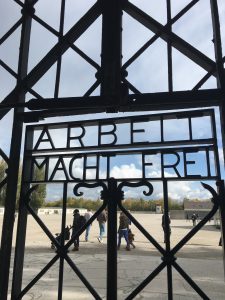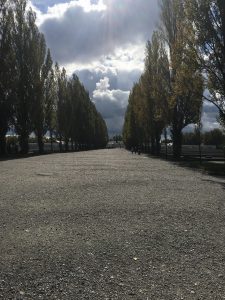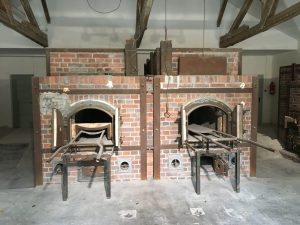Last week I embarked on a journey to Munich, Germany. One of the main reasons I wanted to visit this city is because of its location to Dachau, the concentration camp. Dachau was the first concentration camp to be established in 1933 and is one of three camps remaining that still has the original gas chambers that were used during WWII. For the tour we got on a train at Munich Central Station and went straight to the city of Dachau. This was the first shocking thing which hit me during my time in Munich. Dachau is not just a camp it is actually a city with a vast history composed of much more than just the years where the Nazis used the name as a concentration camp. It is a cute little town that with history going back as far as the Romans who used the town as crossroads for trading. Once we arrived at the station in Dachau, we boarded a bus to head to the official memorial. Once we arrived there one of the first things our tour guide told us was despite not having set foot inside the actual camp yet, we have been walking in the footsteps of the prisoners since the train, with the only exception being instead of being bussed to the camp the prisoners would be forced to walk there. It was then when I realized that I was walking the footsteps of history.
in the footsteps of the prisoners since the train, with the only exception being instead of being bussed to the camp the prisoners would be forced to walk there. It was then when I realized that I was walking the footsteps of history.
Once you arrive at the gates you know where you are. The gate reads ‘Arbeit Macht Frei’ which roughly translates to freedom through work. This saying is more well known at the Auschwitz camp but it actually originated in Dachau. Once through the gates it was impossible not to visualize what the camp might have looked like during the height of the war. Overcrowding, noisy, the smell of death, and fear.
 But the camp also held a bit of beauty in itself, and that beauty was not unintentional, but was a propaganda technique used by the Nazis to try and fool the public by making them think that it was an ordinary reform center where the prisoners were treated fairly. There are these giant trees which lined the middle of the camp in between the two columns of barracks, where the prisoners were forced to cram large numbers into small space. I sent a picture of the layout of the trees to my mom before I told her where I was. She, like a number of people during that time, fell for the Nazi propaganda by saying ‘That’s so pretty.’
But the camp also held a bit of beauty in itself, and that beauty was not unintentional, but was a propaganda technique used by the Nazis to try and fool the public by making them think that it was an ordinary reform center where the prisoners were treated fairly. There are these giant trees which lined the middle of the camp in between the two columns of barracks, where the prisoners were forced to cram large numbers into small space. I sent a picture of the layout of the trees to my mom before I told her where I was. She, like a number of people during that time, fell for the Nazi propaganda by saying ‘That’s so pretty.’
On the tour in Dachau my visualization of the place became more violent as I progressed with the tour. My tour guide explained to us the various torture tactics used during the Nazi regime. One was pole hanging, which is when the arms are tied behind your back and then the victim was hanged by his hands creating an awkward and painful position. On top of this, sometimes the Nazis released dogs to bite on the victim’s feet and legs or came around themselves and pulled on the legs causing immense pain. They also had insane tasks, one being that the Nazis would tell the prisoners to climb the trees and pick off every single yellow leaf because they wanted to keep the camp green, which was impossible when autumn came around.
Visiting Dachau allowed me to put all my knowledge about World War II and the Holocaust into something concrete, especially when I entered the crematorium. In this building you were able to walk through the process of how the victims would be murdered by the Nazis. They were told to take a shower and then entered that actual shower room or better known as the gas chamber. In the shower room there are slits on the wall were the Zyklon B was in
process of how the victims would be murdered by the Nazis. They were told to take a shower and then entered that actual shower room or better known as the gas chamber. In the shower room there are slits on the wall were the Zyklon B was in serted so the Nazis could stay safe from the gas. In this gas chamber up to 150 people could be murdered at a time. There are no words to explain how I felt entering this room. It makes you question how living beings could commit such atrocities. The next room after the shower room was where the bodies of the innocent victims were burned.
serted so the Nazis could stay safe from the gas. In this gas chamber up to 150 people could be murdered at a time. There are no words to explain how I felt entering this room. It makes you question how living beings could commit such atrocities. The next room after the shower room was where the bodies of the innocent victims were burned.
Once we were done in the crematorium it started to sprinkle and the temperature had been in the low 50s the whole day. These two aspects of weather helped to put the history into even more context because we were cold and shivering the whole time, despite wearing jeans and a warm jacket. The prisoners did not have such luxury. They were forced to wear thin material pants and shirts, which did not fit them properly most of the time. They were also not allowed to put their hands in their pockets during role call and would often get frost bite. Visiting and learning about Dachau has made me realize how grateful I am and how important it is to not be blind by what is happening. There have been many genocides since The Holocaust and there will be more unless people learn from history. Because of this it is important to never take people for their word; propaganda and censorship are real.

